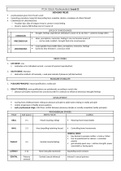Summary
Summary Psychoanalytic, Behaviorism, Humanism Theory (weeks 5/6/7)
Summaries of all the lectures and readings provided for weeks 5/6/7 in Psychology 114. This includes Psychoanalytic Theory, Behaviourism, and Humanism. I include convenient table summaries for dense material, so it's quicker and easier to memorise!
[Show more]



